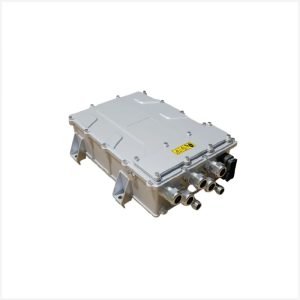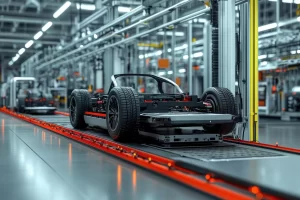The transition from internal combustion engine (ICE) vehicles to electric vehicles has redefined traditional automotive architecture. With this shift, components like electric motors, inverters, and battery systems now take center stage. However, as engineers adapt to new vehicle designs, the terms powertrain and drivetrain are sometimes used interchangeably—despite referring to different subsystems.
Clarifying the distinction between these two is crucial for accurate system design, diagnostics, and performance optimization in EVs.
What is an EV Powertrain?
The EV powertrain is the central system responsible for converting electrical energy from the battery into mechanical energy that propels the vehicle. It includes all critical components involved in power generation, conversion, control, and delivery.
Key Components of the EV Powertrain:
Electric Motor: Converts electrical energy into mechanical torque. Most EVs use AC induction or permanent magnet synchronous motors. These motors also support regenerative braking, capturing kinetic energy during deceleration and feeding it back to the battery.
- Inverter and Power Electronics: Converts the DC power from the battery into AC power for the motor. It also handles the reverse conversion during regenerative braking and manages high-frequency switching for efficient energy delivery.
- Battery Pack and BMS: The battery stores energy, typically using lithium-ion cells. The Battery Management System (BMS) monitors temperature, voltage, and cell balance, ensuring safe and efficient operation.
- Vehicle Control Unit (VCU): Acts as the vehicle’s central processing unit. It integrates data from the BMS, motor controller, and sensors to manage torque requests, regenerative braking, energy efficiency, and drive modes.
- Transmission (if applicable): Unlike traditional ICE vehicles, most EVs use a single-speed transmission due to the wide torque range of electric motors. Some models use direct drive systems that bypass traditional gearboxes altogether.
- Thermal Management System: Regulates temperature across components using cooling plates, heat exchangers, and thermal sensors to maintain optimal performance and prevent overheating or thermal runaway.
Together, these components form the functional backbone of an EV’s propulsion system.

What is an EV Drivetrain?
The EV drivetrain refers specifically to the mechanical components that transfer torque from the electric motor (or transmission) to the wheels. It plays a key role in traction, torque distribution, and vehicle handling.
Key Components of the Drivetrain:
Reduction Gear and Differential: The reduction gear matches motor speed to wheel speed, while the differential adjusts wheel rotation speeds during cornering. This ensures balanced traction and torque delivery.
Driveshafts and CV Joints: These mechanical linkages transmit torque from the differential to the wheels. Constant velocity (CV) joints allow for flexibility in alignment and movement, maintaining smooth operation even when wheels move vertically or steer.
The drivetrain is purely mechanical and doesn’t handle energy conversion. Instead, it ensures that the motor’s output is efficiently delivered to the road surface.
Key Differences Between Powertrain and Drivetrain
| Aspect | EV Powertrain | EV Drivetrain |
| Definition | System that converts and manages electrical energy for motion | Mechanical system that transfers torque to wheels |
| Core Function | Energy conversion, power management, vehicle control | Torque delivery and traction control |
| Includes | Battery, inverter, motor, VCU, power electronics, transmission | Differential, driveshaft, CV joints, axles |
| Control Systems | Highly integrated with sensors, software, and embedded control | Primarily mechanical, with minimal or no electronics |
| Failure Impact | May cause vehicle shutdown or safety hazards | Typically affects motion efficiency or stability |
While both systems work together to enable EV mobility, distinguishing between them is vital for system integration, fault diagnostics, and performance tuning.
Integration in EV Design
In modern electric vehicles, powertrain and drivetrain integration is increasingly optimized for efficiency, compactness, and cost-effectiveness. Automakers often design modular e-axle systems, where the electric motor, inverter, and transmission are packaged into a single unit and mounted directly onto the axle. This simplifies the vehicle layout and reduces energy loss during torque transfer.
Meanwhile, software-defined control plays a larger role in managing both systems. Advanced control units and embedded firmware coordinate regenerative braking, motor torque distribution, traction control, and real-time diagnostics — leading to safer and more energy-efficient driving.
This level of integration emphasizes the importance of precision motor control and real-time system communication, making controller design and parameter tuning critical in modern EV development.

Implications for Performance and Efficiency
Understanding the difference between powertrain and drivetrain is not just academic — it has real implications for:
- Energy Efficiency: A well-designed powertrain maximizes the energy extracted from the battery and minimizes losses during conversion and delivery.
- Drive Comfort and Control: An optimized drivetrain ensures smooth power transmission, better handling, and improved performance on various terrains.
- System Reliability: Clear separation and accurate control of each subsystem help in fault detection, predictive maintenance, and increased lifespan of EV components.
- Customization and Modularity: Knowing the individual roles of each system enables OEMs and Tier 1 suppliers to offer flexible configurations tailored to vehicle type (e.g., passenger EVs, e-buses, or delivery vans).
As EV adoption grows, so does the demand for tailored and efficient motor control solutions — especially for applications with diverse operating conditions and vehicle requirements.
Conclusion
The EV powertrain is responsible for generating and controlling electrical power, while the drivetrain focuses on physically delivering that power to the wheels. Though they function together, each system contributes uniquely to the vehicle’s performance, efficiency, and reliability.
In the rapidly evolving landscape of electric mobility, understanding these systems is essential for design engineers, fleet operators, and system integrators aiming for next-generation EV performance.
GTAKE: Reliable Partner for EV Motor Control Solutions
GTAKE has accumulated solid experience in the application of low-voltage AC drives and motor controllers for new energy vehicles. With continuous investment in research and development, we offer solutions that help customers improve system performance and energy efficiency.
By combining practical engineering expertise with a focus on customization, GTAKE supports vehicle manufacturers and integrators in achieving better control over powertrain and drivetrain systems. Our motor control technologies are developed with attention to real-world application needs — helping ensure stable, safe, and reliable EV operation.
